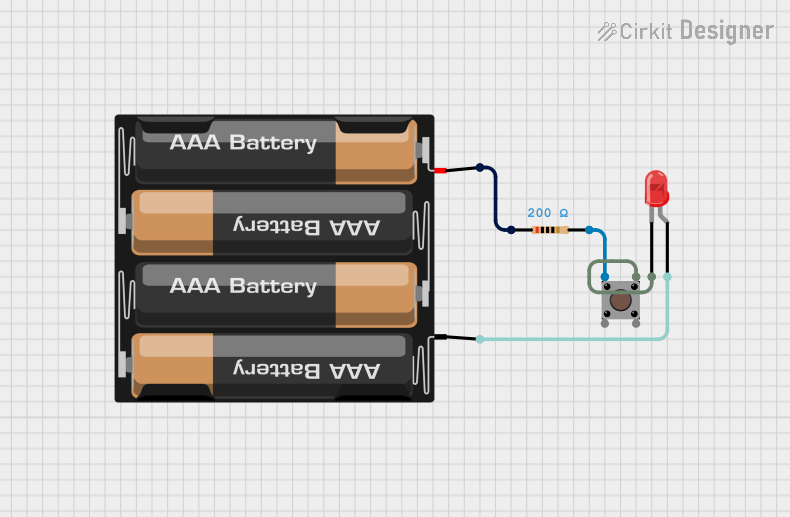
Cirkit Designer
Your all-in-one circuit design IDE
Home /
Project Documentation
Simple Pushbutton-Controlled LED Circuit

Circuit Documentation
Summary of the Circuit
This circuit is a simple pushbutton-controlled LED circuit powered by a 4 x AAA battery mount. When the pushbutton is pressed, the circuit is completed, allowing current to flow from the battery through a resistor and the LED, causing the LED to light up. The resistor is used to limit the current to a safe level for the LED.
Component List
LED: Two Pin (red)
- Description: A red LED with two pins: anode and cathode.
- Purpose: To emit light when current flows through it.
Resistor
- Description: A passive two-terminal electrical component that implements electrical resistance as a circuit element.
- Properties:
- Resistance: 200 Ohms
- Purpose: To limit the current flowing through the LED to prevent damage.
Pushbutton
- Description: A simple switch mechanism for controlling some aspect of a machine or a process. It has four pins: two for the input and two for the output.
- Purpose: To allow the user to control the flow of current in the circuit.
4 x AAA Battery Mount
- Description: A battery mount for holding four AAA batteries, providing a power source for the circuit.
- Purpose: To supply electrical power to the circuit.
Wiring Details
LED: Two Pin (red)
- Cathode: Connected to the output of the Pushbutton (Pin 3).
- Anode: Connected to the negative terminal (-) of the 4 x AAA Battery Mount.
Resistor
- Pin1: Connected to the positive terminal (+) of the 4 x AAA Battery Mount.
- Pin2: Connected to the input of the Pushbutton (Pin 1).
Pushbutton
- Pin 1 (in): Connected to the Resistor (Pin2).
- Pin 3 (out): Connected to the Cathode of the LED.
4 x AAA Battery Mount
- + (Positive): Connected to the Resistor (Pin1).
- - (Negative): Connected to the Anode of the LED.
Documented Code
There is no microcontroller or embedded code associated with this circuit. Therefore, this section is not applicable.
This documentation provides an overview of the circuit components, their purpose, and how they are wired together. The circuit is straightforward and does not include any programmable devices or require embedded code.